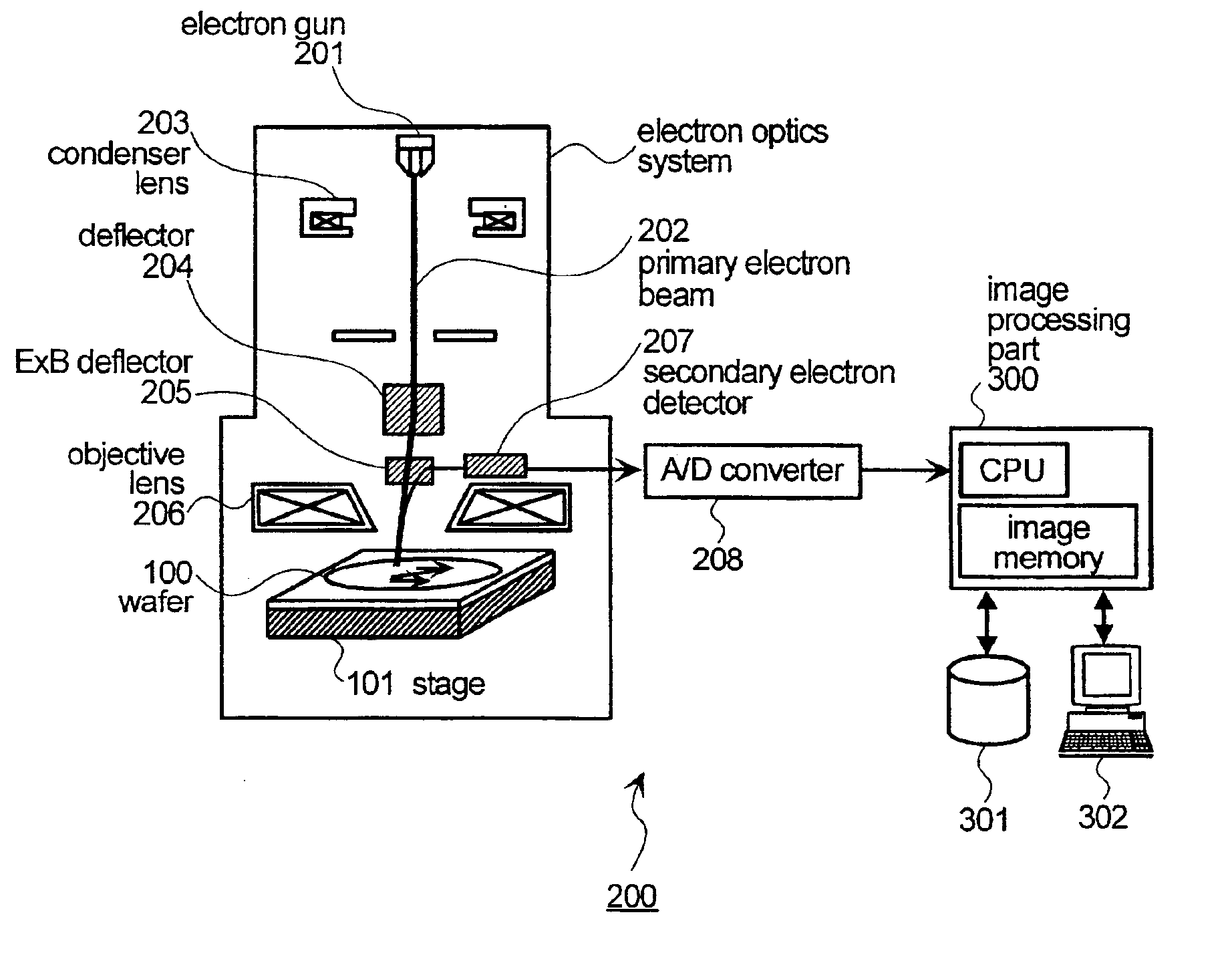Method and system for monitoring a semiconductor device manufacturing process
a semiconductor device and manufacturing process technology, applied in the field of method and system for monitoring a semiconductor device manufacturing process, can solve the problems of inability to obtain desired shape, inability to avoid changes in pattern shape caused by these variations, and difficulty in high-precision shape checking, etc., and achieve the effect of precise alterations of processing condition parameters
- Summary
- Abstract
- Description
- Claims
- Application Information
AI Technical Summary
Benefits of technology
Problems solved by technology
Method used
Image
Examples
first embodiment
(1-0) Fundamental form of Photo Process
[0089]FIG. 1 is a conceptual diagram of the lithography process, according to the first embodiment of the present invention, that uses a lithography-process monitoring system constructed on a CD-SEM 200 (the outline composition is shown in FIG. 10). In this embodiment, the CD-SEM generates the electron beam image (step 2001), subsequently calculates a group of feature quantities (details will be described later) that represent characteristics of a 3-D shape of the resist pattern from the electron beam image (step 2002), evaluates the 3-D shape based on the group of feature quantities, and, at the same time, calculates feedback quantities ΔE and ΔF to the exposure condition parameters (the exposure and the focus) by using a reference database 301 (details will be described later) that has previously been constructed using the FEM wafer (step 2003-2005).
[0090]FIG. 42 shows an example of the composition of a semiconductor production line that incl...
second embodiment
[0130]FIG. 21(a) shows a processing sequence in the lithography process monitoring system constructed on the CD-SEM 200, according to a second embodiment of the present invention.
[0131]In FIG. 21(a), the steps 2001-2005, in which calculation of ΔE and ΔF is fully achieved, are the same as in the first embodiment. Subsequently, ΔE and ΔF, as they are, are not fed back to the exposure equipment, but the feedback quantities ΔE1 and ΔF1 are determined by referring to a history database 303 and using the information of past ΔE and ΔF. For example, in the history database 303, ΔE and ΔF for a few lots in the past are stored, and definitive feedback quantities ΔE1 and ΔF1 are determined by approximating the history data with a straight line, as shown in FIG. 21(b).
[0132]Even under the same exposure and the same focus, a completely identical resist pattern is not necessarily produced when observing it microscopically, and, in addition, ΔE and ΔF that were calculated from each subject of the...
third embodiment
[0134]FIG. 22(a) shows a processing sequence of the lithography-process monitoring system constructed on the CD-SEM 200, according to a third embodiment of the present invention.
[0135]In the first and second embodiments, it is only when the group of feature quantities do not satisfy the conditions at the step 2003 the routine of calculating ΔE and ΔF is performed. However, in this embodiment, even when the group of feature quantities of the subject of the inspection satisfy the conditions, referring to the history database 303 and based on the trends of variations of ΔE and ΔF from the past, the situations in the future are predicted; and, if necessary, fine tuning of the exposure conditions (Δe, Δf) is executed.
[0136]In FIG. 22(b), a range between the alternate long and short dash lines represents a process window. The exposure tends to be on an upward trend and in the next run the exposure is at a risk of going out of the process window. On the other hand, the focus tends to be on...
PUM
 Login to View More
Login to View More Abstract
Description
Claims
Application Information
 Login to View More
Login to View More - R&D
- Intellectual Property
- Life Sciences
- Materials
- Tech Scout
- Unparalleled Data Quality
- Higher Quality Content
- 60% Fewer Hallucinations
Browse by: Latest US Patents, China's latest patents, Technical Efficacy Thesaurus, Application Domain, Technology Topic, Popular Technical Reports.
© 2025 PatSnap. All rights reserved.Legal|Privacy policy|Modern Slavery Act Transparency Statement|Sitemap|About US| Contact US: help@patsnap.com



